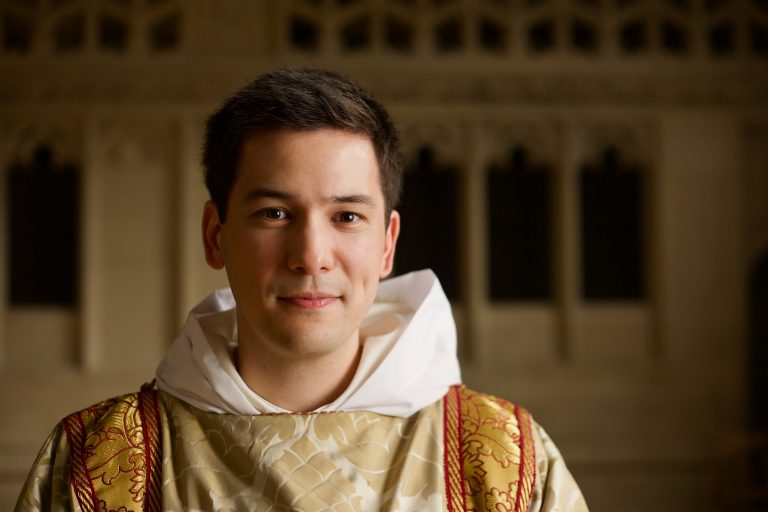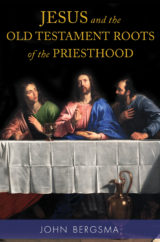By John Bergsma
Dr. John Bergsma is Professor of Theology at the Franciscan University of Steubenville. A former Protestant pastor, Dr. Bergsma has authored several books on Scripture and the Catholic faith, including Jesus and the Old Testament Roots of the Priesthood.

A recovery of the Catholic teaching on priesthood is urgently needed, both among the laity and the clergy.
First of all, we laity need to recover a sense of our priestly status—and that this status is not a lot of talk and theory, but something that makes a difference in how we live our daily lives.
Too often we fall into a “clericalist” mindset—a view of the Church and reality that exaggerates the role of the ministerial priests. We expect priests to be religious professionals who “do the work of the Church” while we just pay our dues to the organization. Oftentimes, growth in the spiritual life, and taking our faith more seriously, is almost identified with “getting more active” in the parish and taking on more para-clerical roles, like lectoring or serving as an extraordinary minister of communion.
While some are called to these roles, they should not be seen as an expression of the royal priesthood of the faithful, whose proper function is to sanctify the temporal order, not assist in the liturgy. Sanctifying the temporal order is quite a mouthful, but it means, basically, making the secular world a holier place: our office, worksite, classroom, and home—wherever it is that we live and work and fulfill our vocation. That is an “outward” looking perspective on the Christian life, not an “inward” one. Advancing in holiness goes hand in hand with moving out into the world, spreading the influence of the kingdom, rather than heading further inside the institutional Church. And a simple glance at the news sites make glaringly clear that we are in critical need of truly priestly Catholics in the media, business, medicine, politics, academia, as well as in the businesses, schools and services that make up the fabric of our everyday lives.
The best way to begin is to start being those “priestly Catholics” ourselves: getting up every morning by offering our day to God by explicit act of prayer, then tackling each task as an opportunity to make it into an offering to God, by doing it with excellence while drawing on God’s grace. So much more can be said on this, but some saints and spiritual writers—notably St. Josemaría Escrivá—have already spent their lives working out the implications of the common priesthood for the daily life of Catholics, and their books are readily available.
No less urgent is a recovery of strong priestly identity among our ministerial priests, our spiritual fathers. As I write this, the nation has been gripped with weeks of violence in our major cities, violence ostensibly provoked by the dismal social and economic conditions of our urban communities. Many solutions are bandied about by pundits and politicians, but only a few, quiet, marginalized voices dare to point out the condition that has perhaps the strongest statistical claim to be responsible for the conditions giving rise to the protests: fatherlessness in our homes. Sadly, this is a problem not limited to urban America, but rapidly growing in other areas and demographics. American culture—and many other modern societies—is suffering the devastating grief of father absence, which leads to so many pathologies: social, psychological, and spiritual.
We moderns are crying out in pain for a loving father in our lives. And in the contemporary situation, I am once again impressed by how God gifts his Church with the answers to the world’s ills. The backbone of the Church is made up of an army of spiritual fathers—for fathers are what priests are in their deepest nature, fathers who image the love of God the Father toward their brothers and sisters on earth.
Since becoming Catholic, I’ve been blessed with so many spiritual fathers in my life, who’ve helped me cope with the pain of life, experience God’s love and forgiveness, and gather the courage to face obstacles on pilgrimage of this life. I’ve also been impressed at how effective the culture of priesthood within the Church is in delivering spiritual care: as a Catholic, I can approach a complete stranger in a foreign country on the other side of the world, and because he is a Catholic priest, within moments I can be unburdening myself of pain in the deepest recesses of my soul and receiving the forgiveness and guidance of a loving Father God through the voice of this man. How we need more men to take up this selfless vocation to be the image and likeness of God the Father toward His children on earth!
You Might Also Like
In Jesus and the Old Testament Roots of the Priesthood, biblical scholar John Bergsma convinces readers that Jesus did, in fact, intend for a ministerial priesthood to be a key feature of the New Covenant.
Bergsma shows how the priesthood is a major thread holding together the biblical story line—beginning with Adam’s loss of the gift of priesthood in the Fall and the long process of restoring his descendants to a priestly status over the centuries, culminating with Christ.


